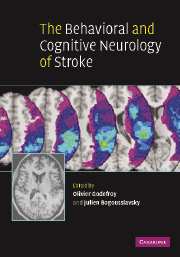Book contents
- Frontmatter
- Contents
- Contributors
- Preface
- 1 Evaluation of cognitive and behavioral disorders in the stroke unit
- Motor and gestural disorders
- Aphasia and arthric disorders
- Hemineglect, Anton–Babinski and right hemisphere syndromes
- Agnosia and Bálint's syndrome
- 14 Cortical blindness
- 15 Bálint's syndrome
- 16 Prosopagnosia
- 17 Object and color agnosia
- 18 Auditory disorders related to strokes
- Executive and memory disorders
- Behavioral and mood disorders
- Dementia and anatomical left/right syndromes
- Index
- References
18 - Auditory disorders related to strokes
Published online by Cambridge University Press: 10 October 2009
- Frontmatter
- Contents
- Contributors
- Preface
- 1 Evaluation of cognitive and behavioral disorders in the stroke unit
- Motor and gestural disorders
- Aphasia and arthric disorders
- Hemineglect, Anton–Babinski and right hemisphere syndromes
- Agnosia and Bálint's syndrome
- 14 Cortical blindness
- 15 Bálint's syndrome
- 16 Prosopagnosia
- 17 Object and color agnosia
- 18 Auditory disorders related to strokes
- Executive and memory disorders
- Behavioral and mood disorders
- Dementia and anatomical left/right syndromes
- Index
- References
Summary
Introduction
Following strokes, disorders of auditory perception produced by lesions located in the territory of the internal carotid artery or of the vertebrobasilar system can be observed. These disorders were gathered in several different clinical forms, now conventional: auditory agnosia is defined as the impossibility of recognizing environmental sounds, words, and music which the patient, however, is said to hear. Pure word deafness is the impossibility of understanding spoken language to repeat or to write under dictation in the absence of another sign of aphasia. Cortical deafness is defined as the feeling of being deaf contrasting with the integrity of the tonal audiogram. Amusia is auditory agnosia specific for music. These central disorders of auditory perception may result from lesions of either the right, left, or both cerebral hemispheres, usually involving parietotemporal cortical areas (Lechevalier et al., 1999). The outcome may be favorable in some cases of cerebrovascular etiology. In reality, such clinical profiles are far from being so distinct. There are intermediate forms, for example: absolutely pure cases of word deafness (relating to only the sounds of language) are extremely rare. Moreover, evolutionary forms were published, initially observed as a form of cortical deafness, then like an auditory agnosia (Godefroy et al., 1995). In spite of these irregularities it seems to us justified to maintain the individuality of these clinical entities, notably because of the acoustic characteristics of the three types of the sounds (musical, verbal sounds, and environmental sounds).
- Type
- Chapter
- Information
- The Behavioral and Cognitive Neurology of Stroke , pp. 348 - 368Publisher: Cambridge University PressPrint publication year: 2007
References
- 4
- Cited by



